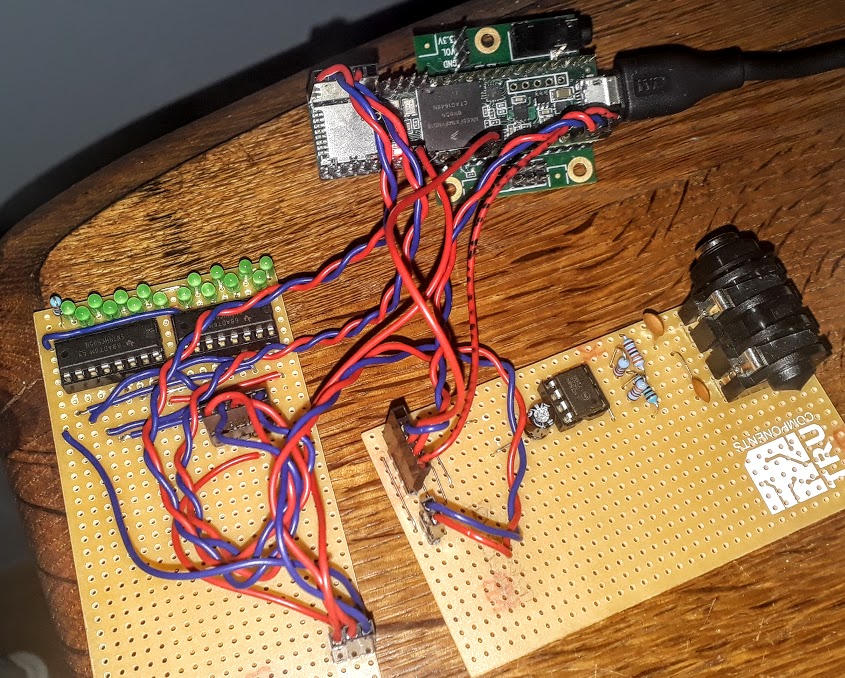In this project I built a guitar tuner similar to a strobe tuner. A strobe tuner uses a strobe triggered by the positive or negative half-wave of a musical instrument signal. The strobe is used to illuminate a disc which rotates at the desired tuning frequency. The disc has a regular pattern on it which seems to be standing still if the instrument is in tune. If the instrument is out of tune, the pattern seems to rotate clockwise or counter-clockwise depending on the sign of the frequency difference between instrument and reference. Strobe tuners allow for a much higher accuracy than tuners based on autocorrelation etc.
Instead of a rotating disc two SN74HC595 shift registers are used as a ring buffer shifting a single one through its sixteen bits. The one is shifted through the buffer with the desired tuning frequency. The outputs of the shift registers are connected to 16 LEDs soldered in one row (they may also be soldered in a circular pattern). To control the shift registers and as a frequency reference a Teensy 3.6 development board is used. The Teensy board is also used for detection of the plucked string. For this purpose an implementation of the YIN algorithm for Teensy Audio Library is used. For the input of the guitar signal a home-made board is used. It contains a non-inverting amplifier with gain 2 and offset of 0.6 V. The amplifier uses a LM358 op-amp.
The software for the Teensy 3.6 development board was written using PlatformIO. It uses the Teensy Audio Library and the audio blocks were wired using Audio System Design Tool for Teensy Audio Library.
The software measures the fundamental frequency of the incoming frequency using the YIN algorithm. From this frequency the most likely string of a guitar is guessed and the tuning frequency is set to the value corresponding to the string. The RCLK and SRCLK are used to shift the bit in the shift register with a frequency of 16 (= number of LEDs) times the tuning frequency.
The software has successfully been tested on Teensy 3.6 and it seems to not work on Teensy 3.2. Maybe it works on Teensy 3.2 with some modifications.
I have tested the hardware and software with a Les-Paul-style electrical guitar and it works great. No more reason to get accused of bad intonation.
10:SRCLR, 11:SRCLK, 12:RCLK, 13:OE, 14:SER, L1,..,L9,LA,..,LH: LEDS
G: Ground (Teensy)
G L8 L7 L6 L5 L4 L3 L2 LH LG LF LE LD LC LB LA
| | | | | | | | | | | | | | | |
08 07 06 05 04 03 02 01 08 07 06 05 04 03 02 01
|-----------------------| |-----------------------|
| sn74hc595 #1 | | sn74hc595 #2 |
|-----------------------| |-----------------------|
09 10 11 12 13 14 15 16 09 10 11 12 13 14 15 16
| | | | | | | | | | | | | | |
| | | | | L1 3V | [same as #1] | L9 3V
| | | | | | |
| | | | | | ----Pin 09 of sn74hc595 \#1
29 31 32 DA 30 ----Pin 14 of sn74hc595 #1
|-----------------------|
| Teensy 3.6 | DA = DAC0
|-----------------------|
A2
3V G 16
| | |
| | |
| | |
| | |
+ G ->
|--------------------------|
| Guitar input circuit | -> = Signal
|--------------------------|
- Design PCB
- Test with Teensy 3.5
- Test with Teensy 3.2 and external frequency generator
